
Geburtssteine für November: Enthüllung des Citrin- und Topas-Duos
Die beiden Edelsteine , die als Geburtssteine für November bezeichnet werden, sind Citrin und Topas , meist gelber Topas. Beide Steine sehen recht ähnlich aus und strahlen die herbstlichen Farben der November-Saison aus.
Der Name des Monats November leitet sich vom lateinischen novem ab, was „neun“ bedeutet, da er in älteren römischen Kalendern der neunte Monat war. Die Angelsachsen nannten den November Blōtmōnaþ, wobei blót „Blutopfer“ bedeutet.
Im November feierten die alten Römer Feste wie Ludi Plebeii (Plebejische Spiele), Epulum Jovis (zu Ehren Jupiters) und Brumalia (Fest zur Wintersonnenwende).
Zu den beliebten Feiertagen im November zählen heute in den USA Thanksgiving und der Veterans Day sowie das christliche Allerheiligen und der mexikanische Tag der Toten.
Im Allgemeinen symbolisiert der Monat Übergang, Einheit und Dankbarkeit.
Entsprechen die Geburtssteine für November dieser Symbolik? Finden Sie es heraus, während wir die Geschichte, Bedeutung, Eigenschaften und den Wert von Topas und Citrin besprechen!
 Oben abgebildet: Madeira-Citrin (links) und Blautopas (rechts)
Oben abgebildet: Madeira-Citrin (links) und Blautopas (rechts)
Historische und kulturelle Bedeutung der Geburtssteine für November
Der November hat zwei Geburtssteine : Topas und Citrin. Aber warum gibt es zwei Geburtssteine für November?
Die kurze Antwort: Topas war der traditionelle Geburtsstein für November und Citrin kam später hinzu.
Die etwas längere Antwort:
Geburtssteine entstanden im 1. und 5. Jahrhundert, inspiriert von biblischen Listen mit zwölf Edelsteinen. Zu dieser Zeit wurde Topas dem Monat November zugeordnet.
Das Tragen von Geburtssteinen begann im 16. Jahrhundert, formalisierte moderne Geburtssteinlisten entstanden jedoch erst 1870, als Tiffany & Co. eine Broschüre mit „Gedichten zu gregorianischen Geburtssteinen“ herausbrachte. In dem Novembergedicht ging es um Topas.
In den ersten standardisierten Listen, die 1912 von der National Association of Jewellers (heute Jewellers of America) und 1937 von der National Association of Goldsmiths erstellt wurden, war Topas für den Monat November aufgeführt.
1952 ergänzte der Jewelry Industry Council of America die Liste von 1912 und fügte für November Citrin hinzu. Dies könnte daran liegen, dass Citrin günstiger war als Topas.
Die aktuellste britische Liste enthält für November nur Topas, während die neueste US-Liste Topas und Citrin enthält.
Welcher ist der häufigste Geburtsstein für November? Topas ist aufgrund seiner Geschichte eher als „klassischer“ Geburtsstein für November bekannt, doch Citrin erfreut sich zunehmender Beliebtheit. Außerdem ist Citrin häufiger als Topas.
Doch wie lässt sich die Geschichte von Citrin und Topas vergleichen?
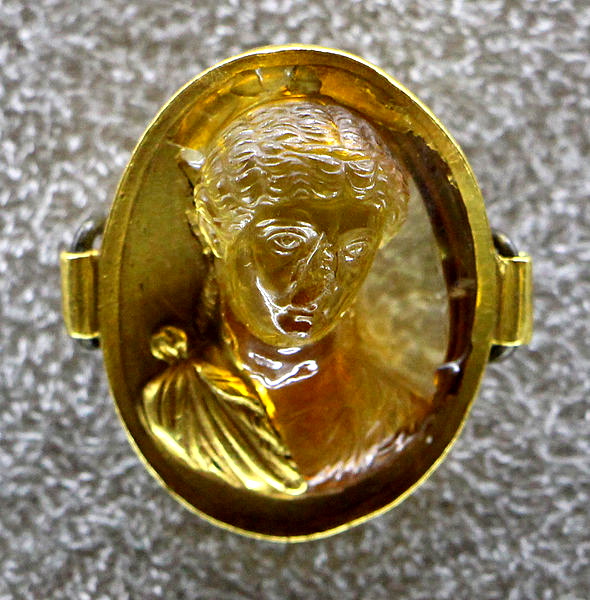 Oben abgebildet: Antike römische Glyptik mit dem Kopf der Faustina aus Citrin, 2. Jahrhundert, im 16. Jahrhundert in Gold restauriert; Ausgestellt im Museo Archeologico Nazionale (Florenz) | Bildnachweis: Sailko, CC-BY-SA-3.0
Oben abgebildet: Antike römische Glyptik mit dem Kopf der Faustina aus Citrin, 2. Jahrhundert, im 16. Jahrhundert in Gold restauriert; Ausgestellt im Museo Archeologico Nazionale (Florenz) | Bildnachweis: Sailko, CC-BY-SA-3.0
Citrins historische Verbindungen
Die erste Zivilisation, die Citrin-Edelsteine verwendete, war das antike Griechenland . Die Griechen verzierten um 300 bis 150 v. Chr. mit Citrin und verbanden den Geburtsstein des Monats November mit der Erntegöttin Demeter. Die alten Römer schnitzten Citrin-Intaglios, und Priester trugen geschnitzte Citrinringe.
Die alten Ägypter brachten Citrin mit ihrer Kriegsgöttin Sachmet in Verbindung, die die Pharaonen beschützte und ihren Anhängern heilende Kräfte zusprach. Sie brachten den Novemberstein auch mit ihrem Sonnengott Ra in Verbindung.
Berichten zufolge trugen chinesische Kaiser Citrinschmuck, um ihren Horizont zu erweitern und Wohlstand zu erlangen. Schottische Soldaten verzierten ihre Waffen mit Citrin und fertigten manchmal sogar die Griffe ihrer Schwerter vollständig aus Citrin.
Der Name „Citrin“ kam jedoch erst 1385 in Gebrauch und wurde für verschiedene gelbe Edelsteine verwendet. Einer dieser Edelsteine war Topas, der jahrhundertelang mit Citrin verwechselt wurde. Obwohl manche Citrin „gelben Quarz“ nannten, nannten ihn andere „Goldtopas“ oder „spanischen Topas“.
Im Jahr 1546 wurde der Name „Citrin“ speziell für gelben Quarz eingeführt, wahrscheinlich abgeleitet vom französischen „Citron“ , was „Zitrone“ bedeutet.
In der Neuzeit stieg die Popularität von Citrinen im Art-Déco- Stil der 1920er und 1930er Jahre rasant an, was auch auf die Verwendung von Citrinschmuck bei Berühmtheiten wie Greta Garbo zurückzuführen ist.
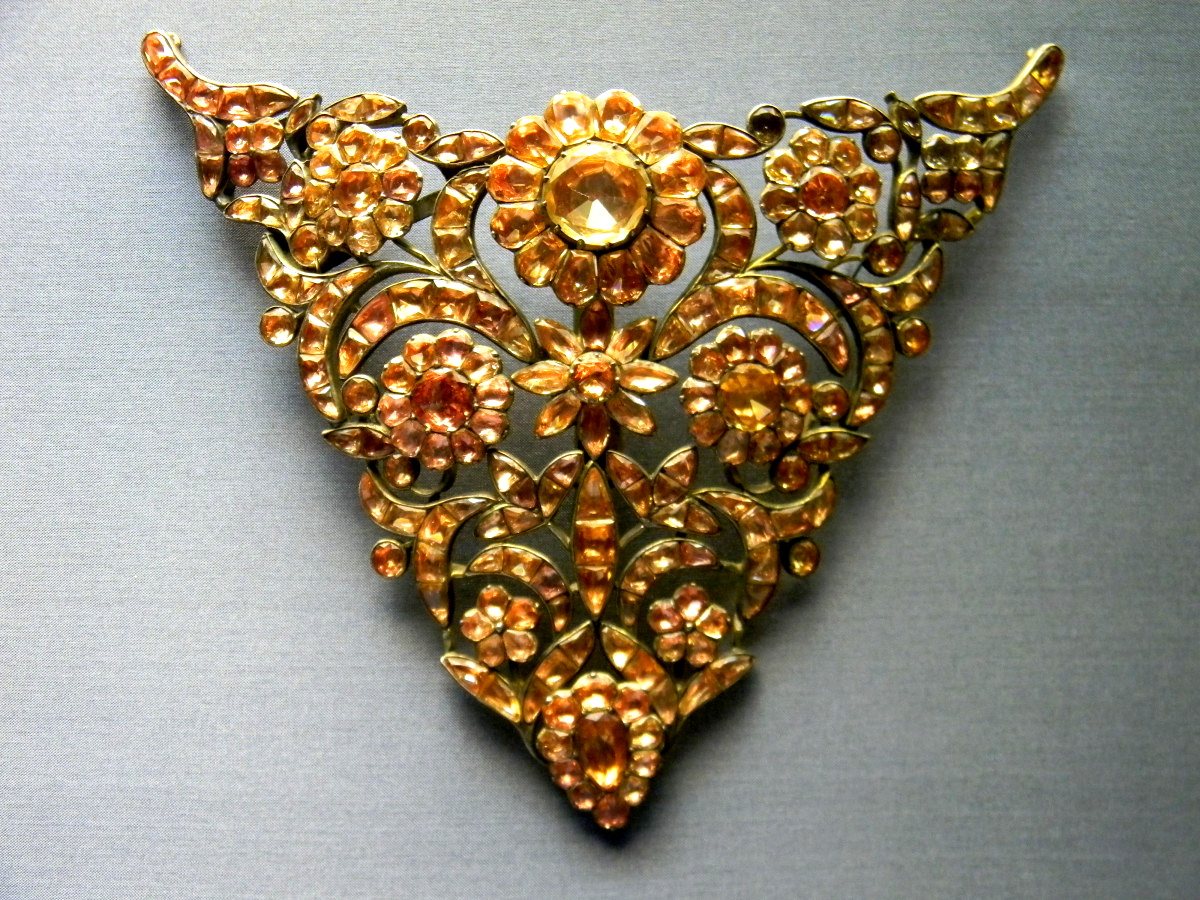 Oben abgebildet: Portugiesisches „Devant de Corsage“ oder Mieder aus Topasen aus dem 18. Jahrhundert; Ausgestellt im Nationalmuseum für Antike Kunst, Lissabon | Bildnachweis: Manederequesens, CC-BY-SA-4.0
Oben abgebildet: Portugiesisches „Devant de Corsage“ oder Mieder aus Topasen aus dem 18. Jahrhundert; Ausgestellt im Nationalmuseum für Antike Kunst, Lissabon | Bildnachweis: Manederequesens, CC-BY-SA-4.0
Das Erbe des Topas in verschiedenen Kulturen
Der Name „Topas“ stammt wahrscheinlich von der Insel Topazios, die die Griechen das heutige Zabargad nannten. Auf dieser Insel wurde jedoch kein Topas, sondern Peridot produziert, der früher mit Topas verwechselt wurde, ähnlich wie Topas und Citrin.
Eine andere Theorie über den Namen des Topas geht auf die Sanskrit-Begriffe „topas“ oder „tapaz “ zurück, die „Feuer“ bedeuten. Sanskrit war die Sprache des alten Indien , wo die Hindus glaubten, dass Topas als einer der Edelsteine des Wunscherfüllungsbaums Kalpa und des astrologisch mächtigen Navaratna schützend und heilig sei.
Die alten Ägypter verbanden Topas mit dem Sonnengott Ra und seinem goldenen Glanz. Ebenso assoziierten die alten Römer Topas mit ihrem Sonnengott Apollo, und die Griechen verbanden Topas mit dem Himmelsgott Jupiter. Im oben erwähnten Navaratna repräsentiert Topas auch den Planeten Jupiter.
Manche Römer glaubten, der Geburtsstein des Monats November würde seine Farbe ändern, wenn er in die Nähe vergifteter Getränke gehalten würde. Andere antike Denker glaubten, die Farbe des Topas würde sich je nach Mondphase intensivieren oder bei Vollmond Krankheiten heilen.
Im Christentum wird Topas mit dem Heiligen Matthäus und seiner religiösen Leidenschaft in Verbindung gebracht. Der Geburtsstein für November wird auch als einer der Steine des Brustpanzers des Hohepriesters und des Neuen Jerusalem erwähnt.
Geologie und Zusammensetzung der Geburtssteine für November
Beginnen wir mit dem Citrin . Dieser Geburtsstein für November ist eine Art Quarz , der aus Siliziumdioxid besteht und eine Mohshärte von 7 hat.
Diese Art von Quarz kommt in Geoden , magmatischen Gesteinen und metamorphen Gesteinen vor. Citrin entsteht häufig durch Wärmebehandlung anderer Quarzarten, aber dazu später mehr.
Die meisten Citrin-Geburtssteine kommen aus Brasilien, aber auch Bolivien, Uruguay, Madagaskar, Mexiko und Spanien zählen zu den wichtigsten Quellen.
Topas ist ein Aluminiumfluorsilikat mit einer Mohshärte von 8. Er entsteht in verschiedenen unterirdischen Bereichen, kommt aber meist in kieselsäurereichen magmatischen Gesteinen vor.
Wie Citrin ist Brasilien die wichtigste Quelle für facettierbare Topase, einschließlich Imperialtopas . Gelber Topas ist auch aus Brasilien, Deutschland und Sri Lanka bekannt.
 Abbildung oben: Facettierter Citrin mit ovaler Form
Abbildung oben: Facettierter Citrin mit ovaler Form
Das warme Leuchten des Citrins: Enthüllung des sonnenbeschienenen Edelsteins
Citrin ist wohl der beliebteste gelbe Edelstein. Seine Farbe entsteht durch Spuren von Eisenverunreinigungen. Der Eisengehalt führt zu verschiedenen Citrin-Farbtönen, darunter Hellgelb, Goldgelb, Orange, Rötlich-Orange und Braun-Orange.
Natürlicher Citrin ist jedoch selten, insbesondere in schöner Färbung. Daher sind die meisten Citrin-Geburtssteine für November das Produkt erhitzter Amethyste oder Rauchquarze .
Die ursprüngliche Färbung des Amethysts kann beeinflussen, wie hell oder matt die Farbe des Citrins sein wird. Erhitzte Rauchquarzsteine neigen dazu, heller gelbe Citrine zu werden.
Natürliche Citrinkristalle sind oft hellgelb und durchgehend rauchig.
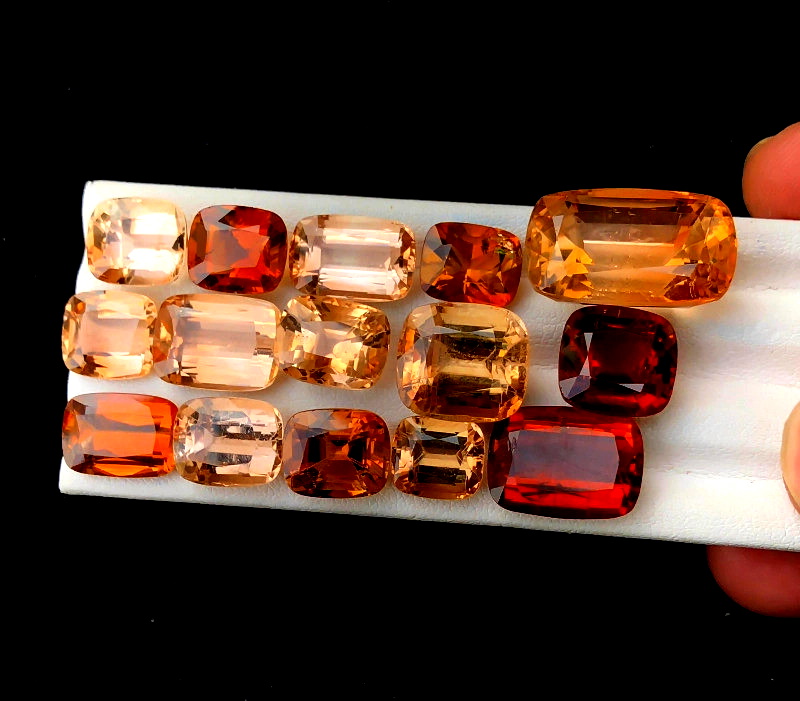 Abbildung oben: Wärmebehandeltes Paket Topassteine in warmen Farben
Abbildung oben: Wärmebehandeltes Paket Topassteine in warmen Farben
Die facettenreiche Schönheit des Topas
Im Gegensatz zu Citrin ist Topas in einer breiten Farbpalette erhältlich. Viele gelbe Edelsteine wurden jedoch historisch als „Topas“ bezeichnet, und gelber Topas galt jahrhundertelang als der einzige gelbe Edelstein.
Heute ist blauer Topas beliebter. Aber ist der Geburtsstein für November blau oder gelb? Die meisten Gemmologen ordnen gelben oder goldenen Topas dem November zu, während blauer Topas eher mit dem Dezember assoziiert wird.
Da Topas allochromatisch ist, entstehen seine Farben durch Verunreinigungen. Die häufigste farbgebende Verunreinigung ist Eisen, das je nach Wellenlängenabsorption verschiedene Farben – wie Braun, Gelb und Blau – erzeugt. Chromverunreinigungen verursachen rosa bis violette Farbtöne.
Natürliche Topaskristalle sind meist farblos, hellgelb, orange oder braun. Blauer Topas ist am beliebtesten, entsteht aber meist durch künstliche Bestrahlung.
Zu den weiteren bemerkenswerten behandelten Topasarten gehören Mystic , Azotic und Center-Fused Topas .
Der wertvollste Topas-Geburtsstein für November ist der Imperialtopas , benannt nach seiner Entdeckung in Russland und seiner Verbindung mit russischen Zaren. Diese Varietät hat eine leuchtend orange, rosa oder korallenfarbene Färbung mit rötlichem Pleochroismus.
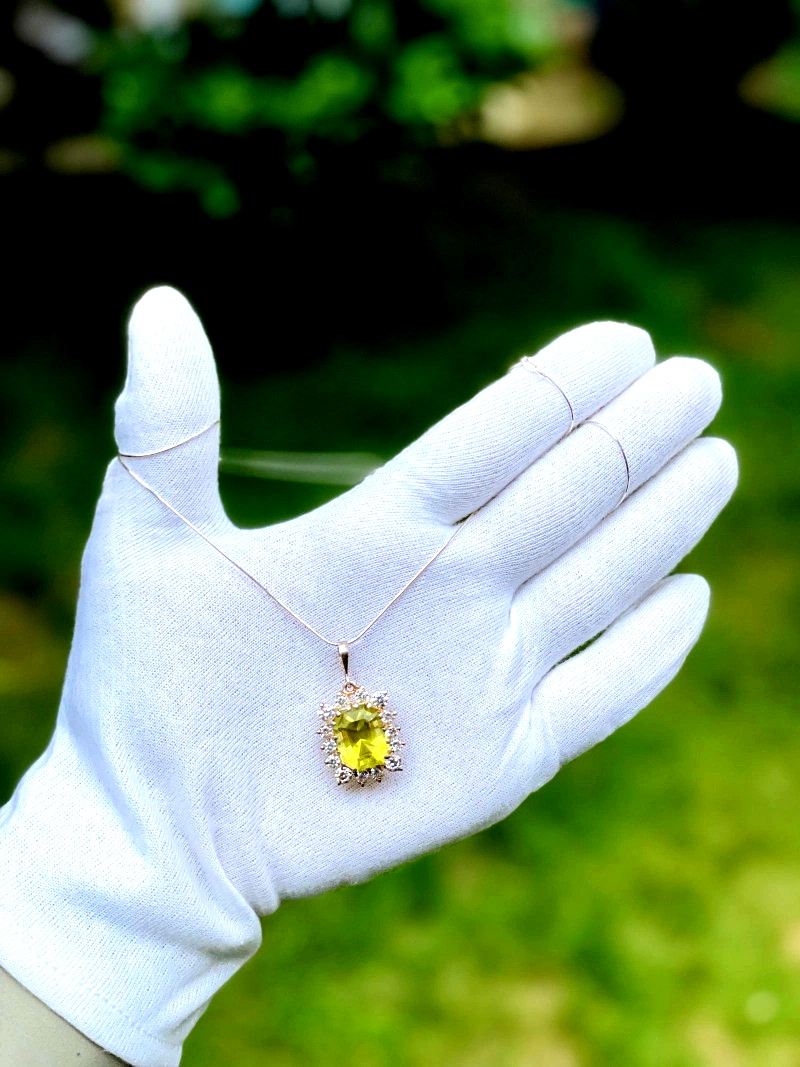 Abbildung oben: Halskette mit Citrin, umgeben von weißen Topassteinen
Abbildung oben: Halskette mit Citrin, umgeben von weißen Topassteinen
Qualitätsbewertung: Eigenschaften von Citrin und Topas
Sowohl Citrin als auch Topas, die Geburtssteine für November, unterscheiden sich in Qualität und Wert je nach Farbe, Schliff, Reinheit, Karatgewicht und Behandlung.
Farbe
Citrin : Die beliebteste Farbe von Citrin ist Rotbraun oder Braunorange. Die wertvollsten Citrinfarben sind jedoch leuchtendes Gelb bis Rotorange ohne braune Untertöne. Ein Beispiel ist der tiefrotorange Madeira-Citrin.
Topas : Die wertvollste und seltenste Topasfarbe ist Rot oder Rosa. Die zweithöchste ist der Imperialtopas, der meist rote Obertöne aufweist. Eine gleichmäßige Färbung des Topas steigert den Wert.
Blau ist in der Natur ebenfalls selten, doch durch Behandlungen entstandene blaue Topase sind häufig anzutreffen. Gelblich-braune bis orangefarbene Topase werden als „Sherrytopas“ oder „Edeltopas“ bezeichnet, obwohl Topas ein Halbedelstein ist.
Weißer Topas ist die günstigste und häufigste Alternative zu Diamanten in Schmuckstücken wie Verlobungsringen .
Schneiden
Citrin : Hochwertige Citrin-Edelsteine werden oft facettiert . Es sind sowohl Standard- als auch Sonderformen in verschiedenen Größen erhältlich. Exemplare von geringerer Qualität können zu Cabochons oder Perlen verarbeitet werden. Viele beeindruckende Citrin-Geburtssteine sind geschliffen.
Topas : Edelsteinschleifer müssen bei der Wahl des besten Schliffs die Farbe, Größe und den hohen Brechungsindex (was ein besseres Funkeln bedeutet) eines Topaskristalls berücksichtigen. Topas-Edelsteine sind jedoch in nahezu jedem Facettenschliff erhältlich.
Smaragdschliffe werden häufig verwendet, um die Farbe und Größe von Topasen hervorzuheben. Ovale und birnenförmige Schliffe verstärken den roten Pleochroismus eines Imperialtopas.
Wie Citrin können auch Topas-Geburtssteine zu Cabochons, Schnitzereien oder Perlen verarbeitet werden.
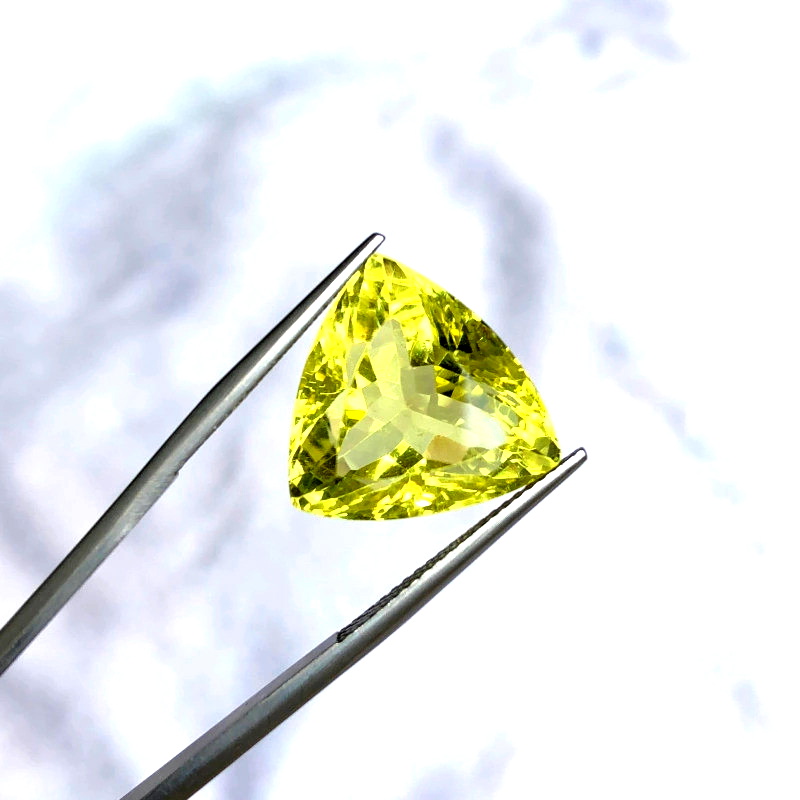 Abbildung oben: Facettierter grünlich-gelber Citrin in Trillionform
Abbildung oben: Facettierter grünlich-gelber Citrin in Trillionform
Klarheit und Transparenz
Die Reinheit beschreibt den Grad sichtbarer Einschlüsse , die die Transparenz und den Wert eines Steins mindern. Beide Geburtssteine für November reichen von transparent bis undurchsichtig, wobei transparentere Optionen höhere Preise erzielen.
Citrin : Citrin kommt häufig ohne sichtbare Einschlüsse vor, daher mindert ihr Vorhandensein den Wert. Auch die Farbzonierung mindert den Wert.
Topas : Die Reinheit von Topassteinen hängt von ihrer Farbe ab. Blauer, gelber und imperialer Topas kommt häufig ohne sichtbare Einschlüsse vor (Reinheitstyp I).
Karatgewicht
Citrin : Citrin-Edelsteine gibt es glücklicherweise in verschiedenen Größen. Steine über 10 Karat haben zwar einen etwas höheren Preis pro Karat, sind aber immer noch erschwinglich.
Topas : Der Karatpreis von Topas-Edelsteinen kann je nach Farbe variieren. Der Preis für Imperialtopas steigt bei 1, 3 und 3+ Karat. Bei Pinktopas steigt der Karatpreis ab 3 Karat. Bei anderen Topasfarben sind die Karatpreise ab 10 Karat höher.
 Oben abgebildet: Facettierter Mystic Topas, hergestellt durch Oberflächenbeschichtung
Oben abgebildet: Facettierter Mystic Topas, hergestellt durch Oberflächenbeschichtung
Behandlungen
Citrin : Wie bereits erwähnt, wurden die meisten erhältlichen Citrin-Edelsteine behandelt. Rauchquarz und Amethyst werden erhitzt, während klarer Quarz erhitzt und bestrahlt werden kann. Einige natürliche Citrine werden für eine intensivere Färbung erhitzt.
Topas : Typische Topasbehandlungen sind Hitze und/oder Bestrahlung, die die Farbe des Geburtssteins verstärken oder verändern. Bestimmte Farben sind stabiler – behandelter Edeltopas verblasst in der Regel nicht, brauner Topas hingegen ist oft lichtempfindlich.
Durch Oberflächenbeschichtung oder Diffusionsbehandlungen entstehen mystischer, azotischer und zentral verschmolzener Topas.
Um das Thema zu wechseln: Was ist die spirituelle Bedeutung der Geburtssteine für November?
 Abbildung oben: Citrin in Blumenform geschnitzt
Abbildung oben: Citrin in Blumenform geschnitzt
Bedeutung der Geburtssteine für November: Kulturelle Symbolik und Glaubensvorstellungen
Die Bedeutung der beiden Geburtssteine für November ist Licht: Wärme, Sonne und Energie. Jeder Stein hat jedoch seine eigene metaphysische Bedeutung.
Citrin – Geburtssteinbedeutungen
Heute symbolisiert Citrin im Allgemeinen Fülle, Wärme und Manifestation.
Alte Glaubenssätze über Citrin -Heilsteine besagten, dass sie Wut lindern und Wohlstand anziehen können. Viele Kulturen glauben, dass Citrin zu Wohlstand und Erfolg beiträgt, weshalb er auch „Stein des Kaufmanns“ oder „Stein des Erfolgs“ genannt wird.
Andere dachten, Citrin ziehe Liebe, Selbstvertrauen und Intelligenz an und vertreibe gleichzeitig Negativität.
Ein weiterer verbreiteter Glaube war der Schutz. Hindus glaubten, Citrin beschütze ihr Wohlbefinden und ihre Schönheit. Alte Kelten und Schotten trugen schützende Citrin-Talismane, um Schlangenbisse und Seuchen zu vermeiden.
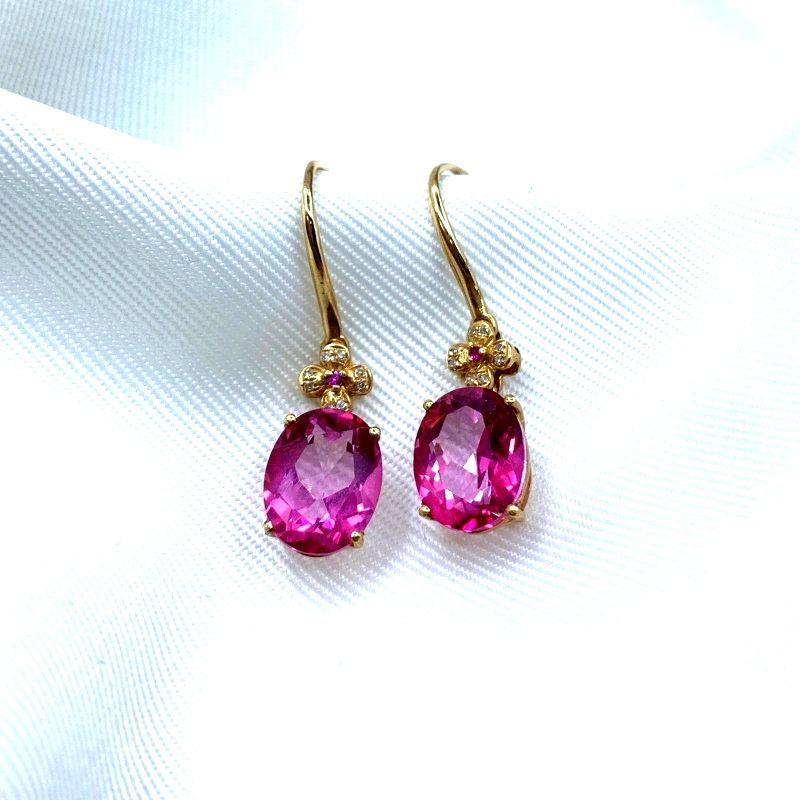 Abbildung oben: Rosa Topas-Ohrringe mit Akzentdiamanten
Abbildung oben: Rosa Topas-Ohrringe mit Akzentdiamanten
Bedeutung des Topas-Geburtssteins
Die moderne Interpretation der Bedeutung von Topas ist, dass er Stärke, Reichtum und Mut repräsentiert.
Topas wurde in der Antike verwendet, um die Kraft zu steigern, die Kraft der Sonne zu nutzen und vor Schaden zu schützen. Die Europäer der Renaissance glaubten, diese Geburtssteine für November würden Flüche beenden und Wut lindern.
Afrikanische Schamanen glaubten, Topas bringe Reichtum. Für die frühen Christen galt Topas als Symbol für Tugend, Glauben und die Liebe zu Gott und dem Nächsten.
Historisch glaubte man, dass Topassteine mit eingravierten Falken Glück bei den Königen bringen und Augenkrankheiten heilen.
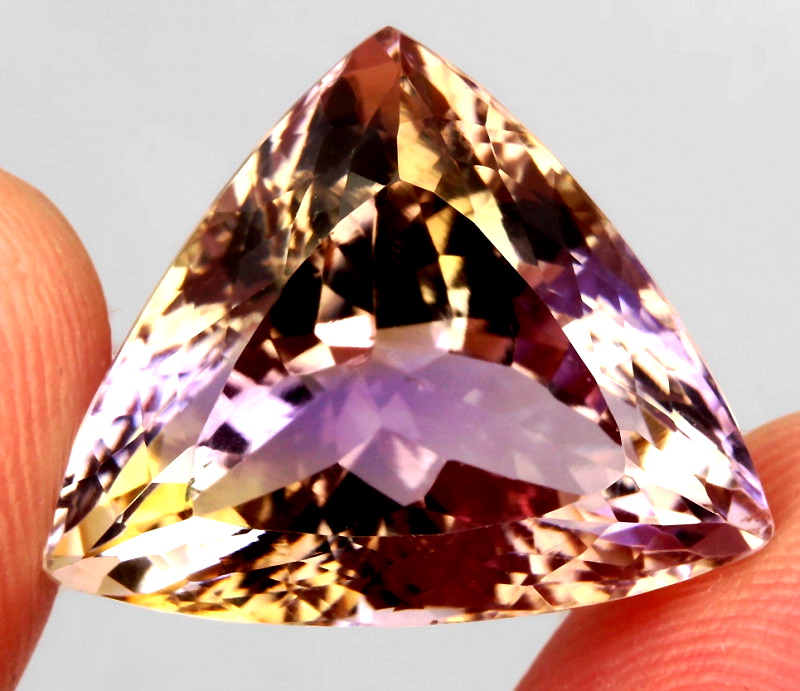 Abbildung oben: Facettierter Ametrin
Abbildung oben: Facettierter Ametrin
Alternative Geburtssteine für November
Obwohl gelber Topas und Citrin traditionell sind, stehen Ihnen viele Geburtssteine für den November zur Auswahl.
Sie können zum einen eine andere Topasfarbe wählen, beispielsweise den günstigeren blauen Topas. Rosa Topas ist eine weitere tolle Option, da er rosa Diamanten ähnelt, aber günstiger ist.
Sie können sich sogar für Ametrin entscheiden, eine violett-gelbe Kombination aus Amethyst und Citrin .
Im November gibt es auch einige alternative gelbe Geburtssteine, wie zum Beispiel:
Rauchquarz
Welcher Geburtsstein ist astrologisch gesehen der für Skorpione im November? Im November (vor dem 22.) geborene Skorpione können von Koralle und Schungit profitieren.
Im November (nach dem 22.) geborene Schützen können von Beryll , Amethyst oder Lapislazuli profitieren.
Personalisierte Geschenke mit Geburtssteinen für November
Wenn Sie sich für Schmuck mit dem Geburtsstein für November entscheiden, fragen Sie sich vielleicht, was besser ist: Topas oder Citrin? Kurz gesagt: Es kommt darauf an.
Topas schneidet in puncto Haltbarkeit und Farbvielfalt besser ab, Citrin hingegen ist erschwinglicher und weist eine größere Größenvielfalt auf.
Wenn Sie einem im November geborenen geliebten Menschen ein Geburtssteingeschenk machen möchten, haben Sie viele Möglichkeiten! Sie können den Edelstein in einen Ring, einen Anhänger, ein Armband oder Manschettenknöpfe mit November-Geburtsstein einarbeiten. Sie können sich sogar für geschnitzte oder raue November-Geburtssteindekorationen entscheiden.
Möchten Sie Ihren Schmuck noch persönlicher gestalten? Sie können den Stein gravieren lassen, ihn mit Ihrem eigenen Geburtsstein kombinieren oder ihn sogar mit der Chrysantheme, der Geburtsblume des Monats November, als Schmuck gestalten lassen.
Außerhalb von Geburtstagen ist Citrin der traditionelle Edelstein zum 13. Hochzeitstag , während Topas an den 4., 19. und 23. Hochzeitstag erinnert.
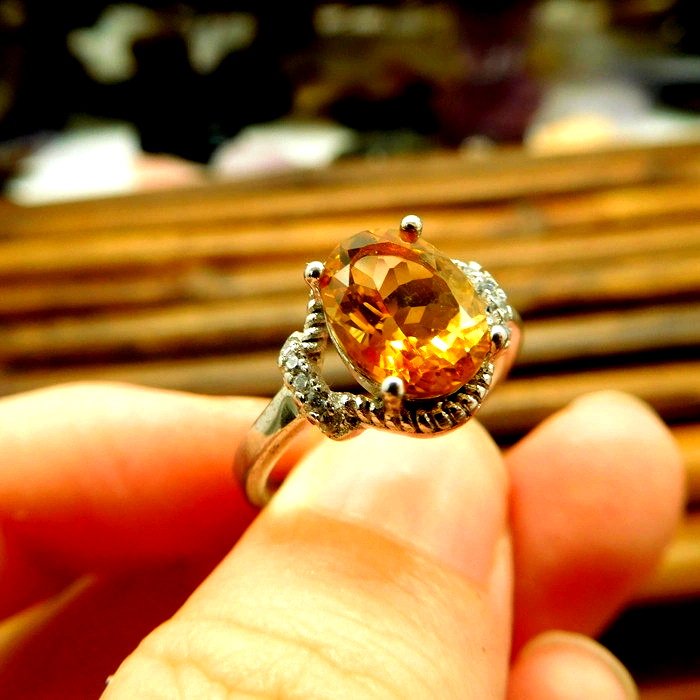 Oben abgebildet: Gelber Topasring
Oben abgebildet: Gelber Topasring
Sind Sie bereit, die Welt der Geburtssteine für November zu erkunden?
Der November ist eine Zeit des Übergangs, von warmem zu kühlerem Wetter und kürzeren Tagen. Doch wie Henry David Thoreau sagte: „Vielleicht ist die Ernte des Novembers an Gedanken mehr wert als alle anderen Früchte des Jahres.“
Topas und Citrin sind wunderbare Edelsteine, um diese Ernte der Gedanken zu würdigen, von geliebten Menschen umgeben zu sein und in dieser farbenfrohen Jahreszeit geboren zu sein.
Suche nach Gemstone Encyclopedia
Verwandte Auktionen
In Verbindung stehende Artikel
Geoden sind atemberaubende Natursteine mit regelmäßiger Oberfläche, aber beeindruckenden Kristallwänden um einen hohlen Kern. Entdecken Sie ihre Herkunft, Sorten, Vorteile und Sammlertipps.
1st May 2018
Amethystkugeln, Amethystgeoden, Amethystkristalle und ein Amethystteich. Entdecken Sie unsere Sammlung außergewöhnlicher Stücke, exklusiv zum Verkauf bei Gem Rock Auctions.
4th Feb 2019
Russland ist ein riesiges Land mit unermesslichen Mineral- und Edelsteinreserven. Russland hat sich zu einem bedeutenden Diamantenproduzenten und -produzenten entwickelt.
9th May 2018
Neue Artikel
Schnitzereien aus Palmenelfenbein, auch pflanzliches Elfenbein genannt, sind eine natürliche Alternative zu Elefantenelfenbein und werden ethisch vertretbar aus den Nüssen der südamerikanischen Phytelephas-Palme gewonnen. Erfahren Sie in diesem Ratgeber alles Wissenswerte über Palmenelfenbein!
15th Jan 2026
Chrysanthemenblütensteine sind Naturwunder mit einem weißen Kalzit-, Celestin- oder Andalusit-Blumenmuster, das sich vom schwarzen Kalkstein oder Tonstein abhebt.
13th Jan 2026
Der Regenbogen-Gitter-Sonnenstein ist eine Feldspatvarietät mit drei wunderschönen optischen Effekten, die durch verschiedene Einschlüsse hervorgerufen werden. Sein feuriges Farbenspiel und das Gittermuster machen ihn zu einem seltenen Sammlerstück!
12th Jan 2026
Artikelkategorien
How To's is where you will find helpful articles from gem Rock Auctions on how to cut gemstones, select gemstones and buy gemstones.
9 Artikel






